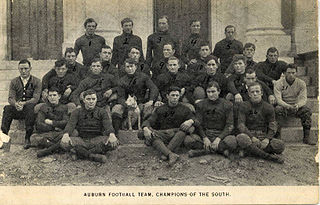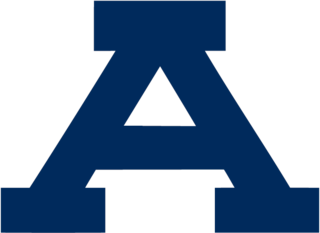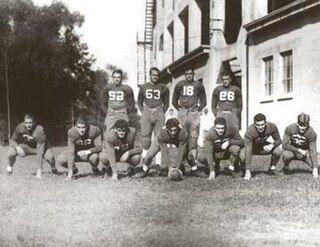Related Research Articles

The 1908 Auburn Tigers football team represented Auburn University in the 1908 Southern Intercollegiate Athletic Association football season. The team went 6–1, outscoring opponents 158–10. Auburn featured a strong defense that held all but one opponent scoreless. The team was the first during the second term of coach Mike Donahue at Auburn.

The 1917 Auburn Tigers football team represented Auburn University in the 1917 Southern Intercollegiate Athletic Association football season. It was the Tigers' 26th season and they competed as a member of the Southern Intercollegiate Athletic Association (SIAA). The team was led by head coach Mike Donahue, in his 13th year, and played their home games at Drake Field in Auburn, Alabama. They finished with a record of six wins, two losses and one tie.

The 1919 Auburn Tigers football team represented Auburn University in the 1919 college football season. It was the Tigers' 28th overall season and they competed as a member of the Southern Intercollegiate Athletic Association (SIAA). The team was led by head coach Mike Donahue, in his 15th year, and played their home games at Drake Field in Auburn, Alabama. They finished with a record of eight wins and one loss and as SIAA champions.

The 1896 Georgia Bulldogs football team represented the Georgia Bulldogs of the University of Georgia during the 1896 Southern Intercollegiate Athletic Association football season. As a member of the Southern Intercollegiate Athletic Association (SIAA), the team provided Georgia with its first undefeated season, compiling a 4–0 record and defeating North Carolina for the first time. The Bulldogs were co-champions of the SIAA with LSU, who joined the conference in 1896.

The 1920 Georgia Bulldogs football team represented the Georgia Bulldogs of the University of Georgia during the 1920 Southern Intercollegiate Athletic Association football season. The Bulldogs had an 8–0–1 record, outscored opponents 250–17, and were also co-champion of the Southern Intercollegiate Athletic Association, with in-state rival Georgia Tech as well as Tulane, which were also undefeated in conference play.
The 1916 Florida Gators football team represented the University of Florida in the sport of American football during the 1916 college football season. The season was C. J. McCoy's third and last as the head coach of the Florida Gators football team. Depleted of first-string football talent and lacking depth, McCoy's 1916 Florida Gators suffered through a disastrous season in which they posted an overall record of 0–5 and a Southern Intercollegiate Athletic Association (SIAA) conference record of 0–4 while scoring a total of three points, leading to the head coach's dismissal.
The 1917 Florida Gators football team represented the University of Florida during the 1917 college football season. The season was Alfred L. Buser's first of three as the head coach of the Florida Gators football team. The 1917 season was a disappointment; the team completed their football season with an SIAA conference record of 1–3 and an overall record of 2–4.
The 1919 Florida Gators football team represented the University of Florida in the sport of American football during the. 1919 college football season. It was Alfred L. Buser's third and last as the head coach of the Florida Gators football team.

The 1920 Florida Gators football team represented the University of Florida during the 1920 college football season. The season was law professor William G. Kline's first of three as the head coach of the Florida Gators football team. Kline's 1920 Florida Gators compiled a marginally better 6–3 overall record than the 1919 Gators, but a lesser 1–2 conference record against Southern Intercollegiate Athletic Association (SIAA) competition.
The 1922 Florida Gators football team represented the Florida Gators of the University of Florida during the 1922 Southern Conference football season. The season was law professor William G. Kline's third and last year as the head coach of the Florida Gators football team. Kline's 1922 Florida Gators finished 7–2 overall, and 2–0 in their first year as members of the new Southern Conference, placing fifth of twenty-one teams in the conference standings.
The 1904 Alabama Crimson White football team represented the University of Alabama in the 1904 Southern Intercollegiate Athletic Association football season. The team was led by head coach W. A. Blount, in his second season, and played their home games at The Quad in Tuscaloosa and at West End Park in Birmingham, Alabama. In what was the twelfth season of Alabama football, the team finished with a record of seven wins and three losses.
The 1911 Alabama Crimson Tide football team represented the University of Alabama in the 1911 college football season. It was the Crimson Tide's 19th overall and 16th season as a member of the Southern Intercollegiate Athletic Association (SIAA). The team was led by head coach D. V. Graves, in his first year, and played their home games at the University of Alabama Quad in Tuscaloosa and the Birmingham Fairgrounds in Birmingham, Alabama. They finished the season with a record of five wins, two losses and two ties.

The 1904 Vanderbilt Commodores football team represented Vanderbilt University during the 1904 Southern Intercollegiate Athletic Association football season. The team's head coach was Dan McGugin, who served his first season in that capacity. Members of the Southern Intercollegiate Athletic Association, the Commodores played six home games in Nashville, Tennessee and finished the season with a record of 9–0.

The 1925 Tulane Green Wave football team represented the Tulane Green Wave of Tulane University in the sport of American football during the 1925 Southern Conference football season.
The 1929 Tulane Green Wave football team represented Tulane University as a member of the Southern Conference (SoCon) during the 1929 college football season. Led by third-year head coach Bernie Bierman and captain Bill Banker, the Green Wave posted a 9–0, undefeated record and outscored opponents 297–45. Tulane compiled a mark of 6–0 in conference play, winning the SoCon title.
The 1930 Tulane Green Wave football team represented Tulane University during the 1930 Southern Conference football season. The team, which was led by fourth-year head coach Bernie Bierman, posted an 8–1 record and shared the Southern Conference (SoCon) title with national champion Alabama. Tulane outscored its opponents 263–30, eliminating six of nine competing teams.

The 1931 Tulane Green Wave football team represented Tulane University during the 1931 Southern Conference football season. The team posted an undefeated regular season, but lost in the Rose Bowl to national champion USC. It is one of the best teams in school history.

The 1906 Vanderbilt Commodores football team represented Vanderbilt University during the 1906 Southern Intercollegiate Athletic Association football season. The team's head coach was Dan McGugin, who served his third season in that capacity. Members of the Southern Intercollegiate Athletic Association (SIAA), the Commodores played seven home games in Nashville, Tennessee at Curry Field, and finished the season with a record of 8–1 overall and 5–0 in SIAA.

The 1902 Vanderbilt Commodores football team represented Vanderbilt University during the 1902 Southern Intercollegiate Athletic Association football season. W. H. Watkins was in his second year coaching Vanderbilt. Vanderbilt was playing in its 13th season of football. The Commodores had wins over Cumberland, Ole Miss, Central of Kentucky, Tennessee, Washington University, Kentucky, Tulane and LSU. The Tulane and LSU contests were played with one day's rest between games for the Commodores.
The 1926 Georgia Tech Golden Tornado football team represented the Georgia Tech Golden Tornado of the Georgia Institute of Technology during the 1926 Southern Conference football season. The Tornado was coached by William Alexander in his seventh year as head coach, compiling a record of 4–5.
References
- ↑ Ryan Whirty (June 26, 2012). "The History of Tulane Stadium(s)". Gambit Magazine. Retrieved September 11, 2012.
- ↑ "Tulane University Official Athletic Site". Archived from the original on June 19, 2016. Retrieved May 18, 2016.
- ↑ Tulane Football History Archived 2016-03-31 at the Wayback Machine , Tulane University, retrieved August 15, 2010.
- ↑ Leonard Victor Huber, New Orleans: A Pictorial History, p. 258, Pelican Publishing, 1991, ISBN 0-88289-868-X.
- ↑ Dawson's Tulane System Designed For Super-Power, The Palm Beach Post, December 17, 1939.
- ↑ "GERMAN" SCHULZ NAMED DIRECTOR TULANE SPORTS Archived 2012-11-03 at the Wayback Machine , The Atlanta Constitution, July 25, 1920.
- ↑ "Greenbacks swamp Southwestern, 79–0". The Birmingham News. October 3, 1920. Retrieved September 5, 2021– via Newspapers.com.
- ↑ "Tulane wins from Mississippi, 29–0". The Birmingham News. October 10, 1920. Retrieved September 1, 2021– via Newspapers.com.
- ↑ "Rice Owls are held to scoreless tie by Tulane". The Houston Post. October 17, 1920. Retrieved April 2, 2022– via Newspapers.com.
- ↑ ""Ole Miss" beaten; Holds Tulane scoreless in first half, but then loses, score 32 to 0". The Commercial Appeal. October 24, 1920. Retrieved April 2, 2022– via Newspapers.com.
- ↑ "Michigan beats Tulane, 21 to 0". Detroit Free Press. October 31, 1920. p. Sports 1. Retrieved April 2, 2022– via Newspapers.com.
- ↑ "Tulane scores twice at Tampa". The Miami Herald. November 7, 1920. Retrieved April 2, 2022– via Newspapers.com.
- ↑ "Mississippi falls before Tulane, 6–0". The Atlanta Constitution. November 14, 1920. Retrieved April 2, 2022– via Newspapers.com.
- ↑ "Tulane defeats L.S.U. in their annual clash 21 to 0". The Shreveport Times. November 26, 1920. Retrieved April 2, 2022– via Newspapers.com.
- ↑ "Detroit wins from Tulane by touchdown". Detroit Free Press. December 5, 1920. pp. 21, 23. Retrieved April 2, 2022– via Newspapers.com.
- 1 2 3 4 5 6 7 8 9 10 11 Jambalaya, 1921
- ↑ "History of the Green Wave - Tulane University Official Athletic Site". Archived from the original on March 24, 2016. Retrieved May 31, 2016.
- ↑ "Year-By-Year Summaries (1920s) - Tulane Official Athletic Site". Archived from the original on December 29, 2010. Retrieved May 31, 2016.
- ↑ "Michigan Beats Tulane, 21 to 0". Detroit Free Press. October 31, 1920. p. Sports 1.
- 1 2 3 "'Gators Put Up Strong Fight Against Tulane". The Florida Alligator. Vol. 19, no. 17. November 12, 1920.
- ↑ "'Gators Trimmed By Tulane". The Atlanta Constitution. November 7, 1920. p. 2. Retrieved July 23, 2016– via Newspapers.com.

- 1 2 3 "Mississippi Falls Before Tulane, 6- 0". Atlanta Constitution. November 14, 1920. p. 3.
- ↑ Woodruff 1928 , p. 139
- 1 2 3 "Detroit Defeats Tulane". The Atlanta Constitution. December 5, 1920. p. 3. Retrieved May 18, 2016– via Newspapers.com.

Additional sources
- Woodruff, Fuzzy (1928). A History of Southern Football 1890–1928. Vol. 2.